Amazon Kindle Fire Review
by Anand Lal Shimpi & Vivek Gowri on November 29, 2011 3:31 AM EST- Posted in
- Tablets
- Mobile
- Amazon
- Kindle Fire
- Kindle
The iPad Comparison
I'll be honest here (I always am?): I don't understand the iPad comparison. The Kindle Fire and iPad 2 couldn't be more different. They are vastly different sizes, shapes and prices. They even serve slightly different functions. The search for an iPad killer reminds me of the search for a Voodoo killer back during the heyday of 3dfx in the late 1990s.
The Kindle Fire serves entirely different purposes than to take marketshare away from Apple.
Why would Amazon enter the IPS LCD equipped multitouch tablet business to begin with? For users who are content reading ebooks on an e-ink screen, the vanilla Kindles are as good as they get. The problem is for users looking to consolidate devices, they may find themselves carrying a Kindle and a tablet of some sort (likely an iPad) and will ultimately ditch the Kindle in favor of the iPad. Should these users replace their Kindles with iPads, there's the argument that Apple could tempt them away from Amazon's Kindle store altogether. If they want a more affordable tablet however they are likely going to be forced into a solution that's probably not very good. Neither possibility is something Amazon likes, so the obvious answer is to offer a Kindle that delivers enough of the tablet experience that will satisfy those users looking for more than an e-ink Kindle could provide.
The Fire is that Kindle.
No Tradeoffs: Compute & Display
When faced with the task of bringing a not-sucky $200 tablet to market, Amazon refused to skimp in two areas: compute and the display. It reaffirms something that we've known for quite a while: to deliver the best user experience you still need fast silicon and a great display. The third thing you need is efficient software, which is something Amazon attempted to deliver by customizing Android, but I'll get to that later.
The SoC doesn't sound fast anymore, not with Tegra 3 and Krait waiting around the corner, but the OMAP 4430 is still one of the fastest things you can buy today. It features two fully equipped Cortex A9 cores (complete with MPE), a 1MB shared L2 cache, two 32-bit LPDDR2 memory channels and a PowerVR SGX 540. CPU clocks aren't as high as they could be at 1GHz, but if Amazon does its job well enough on the software side they should be sufficient. To put things into perspective, this is more general purpose compute than the original iPad and something competitive with the iPad 2. It only falls short of the iPad 2 in the GPU department, but seeing as the Kindle Fire isn't designed to be a big gaming platform the loss isn't significant.
| Tablet Specification Comparison | ||||||
| Amazon Kindle Fire | Apple iPad 2 | BlackBerry PlayBook | Samsung Galaxy Tab 8.9 | |||
| Dimensions | 190 x 120 x 11.4mm | 241.2 x 185.7 x 8.8mm | 194 x 130 x 10mm | 230.9 x 157.8 x 8.6mm | ||
| Display | 7-inch 1024 x 600 IPS | 9.7-inch 1024 x 768 IPS | 7-inch 1024 x 600 | 8.9-inch 1280 x 800 PLS | ||
| Weight | 413g | 601g | 425g | 447g | ||
| Processor | 1GHz TI OMAP 4430 (2 x Cortex A9) | 1GHz Apple A5 (2 x Cortex A9) | 1GHz TI OMAP 4430 (2 x Cortex A9) | 1GHz NVIDIA Tegra 2 (2 x Cortex A9) | ||
| Memory | 512MB | 512MB | 1GB | 1GB | ||
| Storage | 8GB | 16GB | 16GB | 16GB | ||
| Pricing | $199 | $499 | $199 | $469 | ||
The Fire is equipped with only 512MB of RAM but, once again, if Amazon does its job on the software side this should be sufficient. Moving to 1GB would allow you to keep more applications active at once and pave the way for more textures in games, but as I just mentioned, the Fire isn't much of a gaming platform to begin with.
The display is small by iPad standards, but as I mentioned in our PlayBook review, it does make the device far more likely to be by your side wherever you may go. The iPad and other 10-inch tablets make for a far better web browsing experience, but they are too big to just carry around with you like you would a wallet or smartphone. The Kindle Fire is bigger than anything that should occupy space in your wallet, but it's small enough that you might actually take it wherever you go.
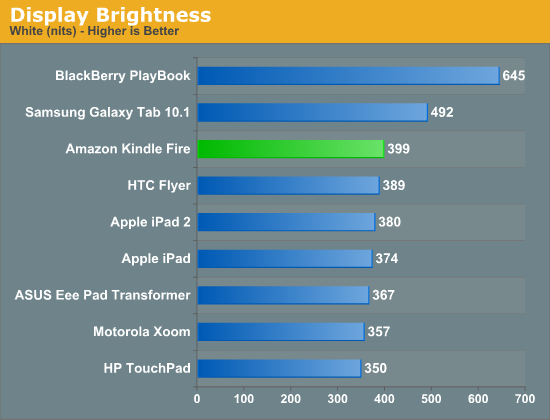
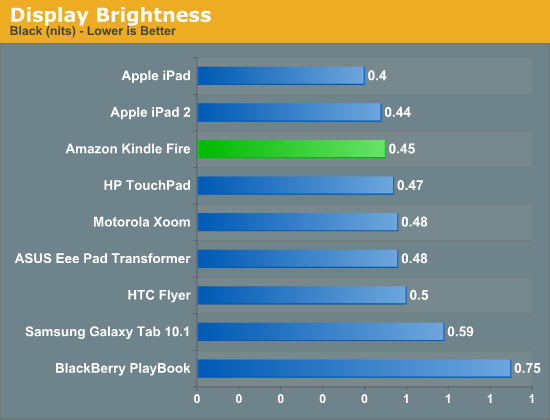
Display quality is pretty good. The 7-inch 1024 x 600 screen hits 400 nits at its brightest setting, and its black levels are reasonable at 0.45 nits. The resulting contrast ratio is good as well.
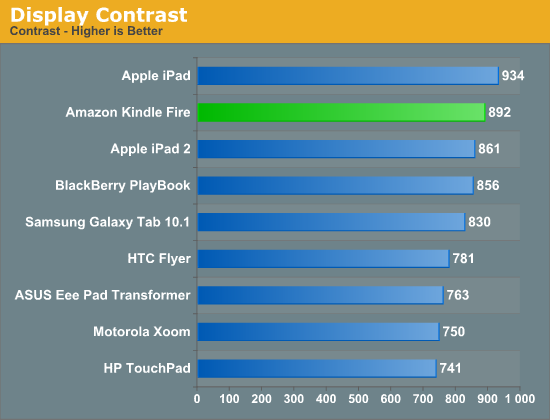
The white point is an almost Samsung-like 7200K across all brightness settings. Interestingly enough there's no difference in brightness once you get below 25% on the slider control.
The Form Factor
The first Kindle I ever bought was the second generation model. Upon receiving it I felt that it was the perfect handheld tablet form factor. The 2nd generation Kindle was both thin and light enough that it could truly be a book replacement. I'd carry it everywhere and it wasn't a burden to hold and read for hours.
The Kindle Fire strikes me with no similar feelings about its form factor. It's portable, more so than the iPad and it's reminds me of my old Kindle in surface area but that's it. The Fire is light enough to be held in one hand but when reading for extended periods of time I still find myself having to support the device with my chest if I'm lying on my back. There's simply no innovation in the form factor. While my old Kindle was the perfect form factor, the Fire is just acceptable.
This isn't all Amazon's fault however. The hardware in a plain old Kindle allows Amazon to build something ultra thin and ultra light. Moore's Law has yet to give us something that can perform as well as the Fire while operating within the confines (battery included) of a regular Kindle. I suspect that we'll eventually get to that point, however it may take a good three years for that to happen.
The standard Kindle's e-ink display is beautiful to read pages of books on, but it is hardly desirable for images or web content. The Kindle Fire is a bit better, but still not perfect in this regard. In text mode reading magazines or books is as pleasant as can be given that you're staring at an LED backlit LCD. If you're just going to be reading books, the experience on a vanilla Kindle is better. The advantage to the Fire of course is that you can do more than just read pages of text - it's good for magazines and web pages as well.
Unfortunately here the 7-inch 1024 x 600 display is limiting. It's virtually impossible to read a magazine (in magazine view) fully zoomed out like you would a book. I found myself preferring the text view of magazines I tried subscribing to on the Kindle Fire. Web browsing is more of a mixed bag. You get a really great browsing experience compared to a smartphone, or a really cramped browsing experience compared to an iPad. This is the same problem I pointed out in our PlayBook review:
Even when I'm not out and about, the PlayBook is quite usable as a content consumption device. In portrait mode fonts are a bit too small for me to read comfortably on the couch but in landscape it works well as a reddit browsing machine.It's in the couch-lounging usage model that the PlayBook does fall short of the iPad or Xoom. But in terms of portability the PlayBook is clearly a much better balance of functionality and mobility. If you read between the lines you'll come to the same conclusion I have: neither the PlayBook nor the iPad is the perfect form factor for a tablet. Further more, I'm not sure there is a single perfect tablet form factor.


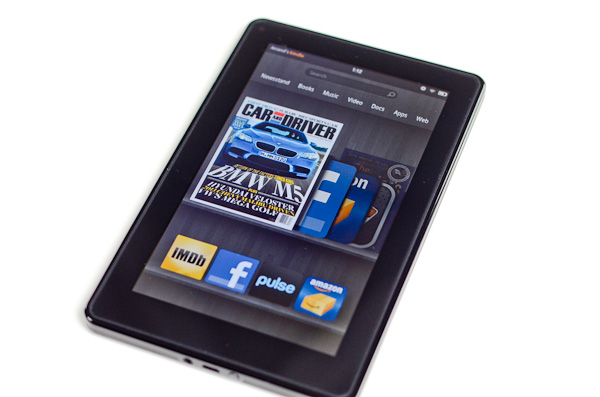
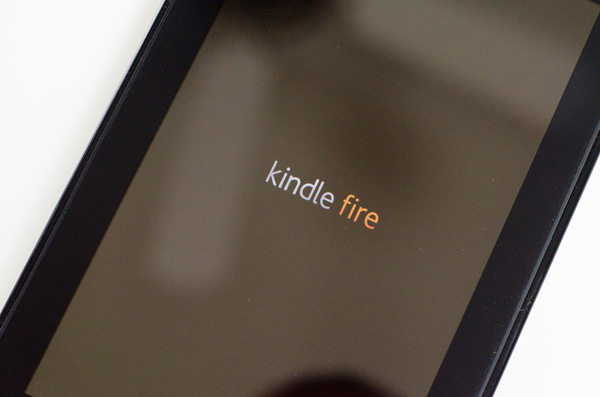
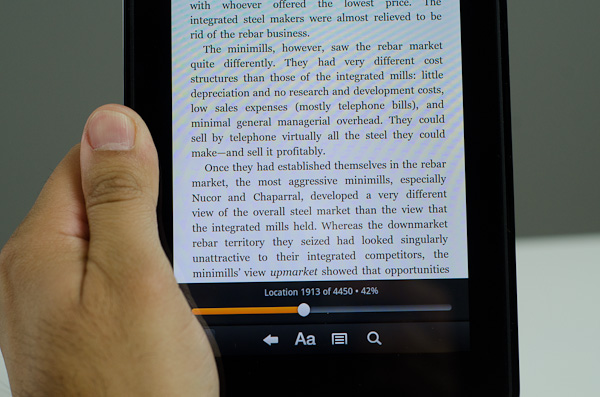
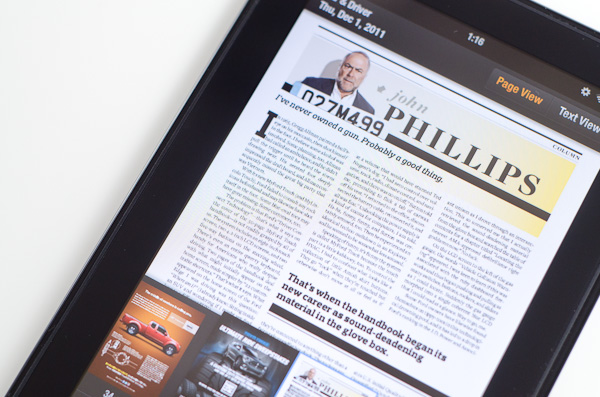








70 Comments
View All Comments
Fincanejoe - Tuesday, November 29, 2011 - link
I will try to correct you but you are so turned around a far off the path that this may be difficult.I own a Kindle 2 as well as a Kindle Fire and have owned a ipad and android tablet:
* No one who owns a Kindle (non Fire) would ever suggest Kindle Fire, ipad, or Android tablet could ever replace the passive - not light emitting - Kindle as a reader. Anyone who has stared at a computer screen for too long and/or Kindle owners understand this.
* Kindle Fire is not trying to accomplish all the tasks the ipad or android tablets are trying to accomplish. That's just it "trying to accomplish".
The ipad and droid tablets are tweeners trying to accomplish what laptops do well and cell phones do well all in one device. The problem is none of the tablets does the job very well at his point and. They are "cool" devices but one the cool wears off and reality sets in you realize a tablet is not as good as a laptop (for what laptops do) and not good enough as a cell (for what cells do) to replace either. That's why I returned my ipad and adroid tablet after the cool factor wore off (couple of days).
The Kindle Fire does not try to bite off such a large chunk of the pie. It fills a smaller niche and does it well. I use my google account (mail,docs,etc) and Amazon account for storing content. What the Kindle fire does is manage and connect me to all this content exceptionally well with a better screen, much longer battery life, smaller footprint. ipad is too big, this device is just the right size for this purpose. And yes if I want to read a book in a pinch amazon sync bookmarks where I left off on my real reader, Kindle 2.
Lets not for get this small item either - K Fire sets you back $200 while the ipad sets you back at least $600 until the next great device comes around in about 6 - 12 months.
This is how Kindle Fire is an Apple ipad market share "stealer" not killer. Sure there will be the Apple fanboys but aside from that, the practical people will stick to their laptops, cell phones, and Kindles.
solipsism - Tuesday, November 29, 2011 - link
Lots of hate for tablets. You might want to rethink that for a more objective position.Sabresiberian - Wednesday, November 30, 2011 - link
Ummm - well, if he hates tablets, I say he has a right to, since he has actually bought them and used them. He at least had an open enough mind to try them out before he decided that they don't work very well.;)
joshv - Wednesday, November 30, 2011 - link
"No one who owns a Kindle (non Fire) would ever suggest Kindle Fire, ipad, or Android tablet could ever replace the passive - not light emitting - Kindle as a reader. Anyone who has stared at a computer screen for too long and/or Kindle owners understand this."Incorrect. I love the passive Kindle display, but I also read a lot in bed, and I hate the hack of an external LED (clipon or otherwise). The Fire works great in bed, and I suffer no eyestrain whatsoever. It's pixel density is also quite high, so text looks smooth and clear.
I've really never understood the LED eyestrain thing. It just seems like a self-perpetuating meme. People hear it, and when their eyes hurt they go "yeah, must be because I stare at an LED screen all day long".
wicko - Wednesday, November 30, 2011 - link
Yeah, I seriously doubt it's the LCD screen that's causing eye-strain or headaches. I look at LCDs 10-12 hours a day, as do many others, and I don't have any problems like that. Sure, there are some more sensitive to light then others (I have brown eyes, which are the least susceptible to problems like that), but it isn't a general thing that happens to everyone, and I see no proof that it's the LCD itself. I start getting headaches when I play Battlefield 3 for too long, and I imagine it's because I'm getting blasted with colour, fast moving objects, and, probably the main cause, sounds of explosions and weapon fire. But I don't have these problems when I'm programming/browsing/etc.wicko - Wednesday, November 30, 2011 - link
Also forgot to mention, when I'm playing BF3 and I get those headaches, it's because I've been playing for 4-5 hours straight. If I took breaks in between, I wouldn't need to take tylenol :pReflex - Wednesday, November 30, 2011 - link
You just said you have no problems with LCD's, but then you listed your problems with LCD's.I think you've missed the point. On eInk there is no need for a break after an hour or two. The screen does not fatigue the eyes. Even if it were in full motion, 3D with color as rich as a LCD, it would not fatigue the eyes to watch.
joshv - Thursday, December 1, 2011 - link
I can read my Fire and stare and LCD monitors all darned day long. No headaches, no eyestrain.Finraziel - Thursday, December 1, 2011 - link
Nope, with e-ink I get a neckstrain because I lie in uncomfortable positions keeping the damn thing within the light... I was actually going to post because I was surprised at Anand/Vivek so boldly stating that e-ink is better than LCD for reading, it's not that simple and just because a lot of people prefer e-ink does not change the fact that it's a matter of preference.I myself gave my e-ink device (not a kindle but a sony pocket edition, unfortunately I'm on the wrong side of the atlantic, can't get a fire either...) to my mom because I found that I actually preferred reading on my phone(!) to using the e-ink device, exactly because I usually read in dim/dark conditions and as good as never in direct sunlight.
genomecop - Thursday, December 1, 2011 - link
Couldn't agree more.